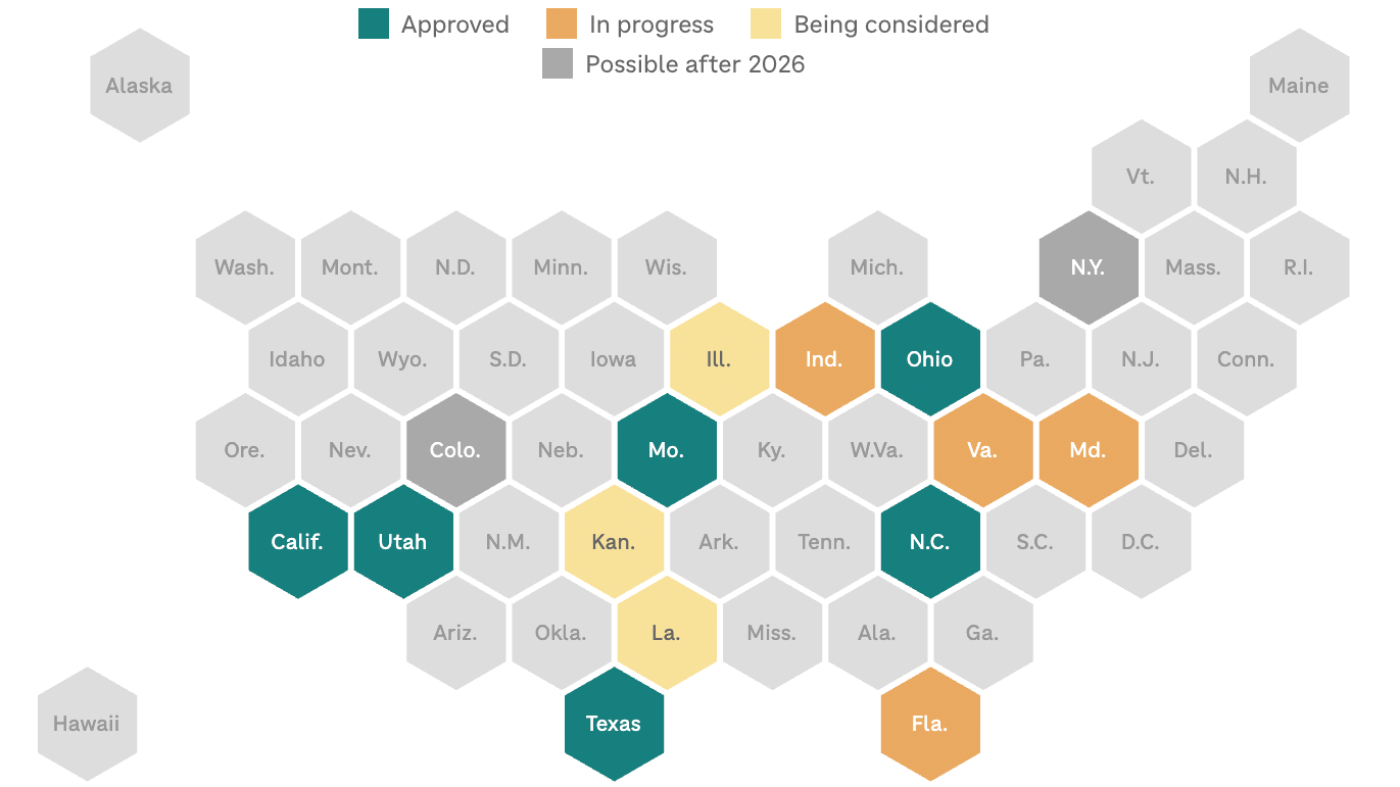New Jersey
New Jersey lottery player wins $1 million in Saturday’s Powerball

A ticket sold in New Jersey won $1 million in Saturday night’s Powerball, according to the Powerball website.
The ticket matched all five white balls to win the million-dollar prize.
It was not immediately known where in the Garden State the winning the ticket was sold.
Powerball jackpot up to $285 million
There was no winner so the lottery jackpot will increase to an estimated $285 million with a cash option of $124.9 million for Monday night’s drawing,
The jackpot was last won on Dec. 7 when a New York lottery player won a $256 million Powerball jackpot.
Powerball winning numbers for 1/11/25
Here are the Powerball winning numbers for Saturday, Jan. 11, 2025: 3 – 6 – 32 – 37 – 65 and Powerball 4. Powerplay was 3x
When is the next Powerball drawing?
Powerball drawings are held three times a week – Monday, Wednesday and Saturday at 10:59 p.m. Monday drawings were added in 2021.
How late can I buy Powerball tickets?
The deadline for purchasing Powerball ticket varies by state so don’t wait until the last minute. The deadline in New Jersey is 9:59 p.m. on the day of the drawing, while New York’s deadline is 10 p.m.
Click here is a complete list of Powerball ticket deadline times by state or jurisdiction.
How do I play Powerball?
The cost is $2 per ticket, but you can add the Power Play for $1, which will increase the amount of your potential prize up to five times the original prize (except for the jackpot and Match 5). There is also a 10x Power Play possibility when the jackpot is less than $150 million.
Each player selects five numbers from 1 to 69 for the white balls and one number from 1 to 26 for the red Powerball. However, you can also have the lottery machine generate a quick pick ticket with random numbers for you.
Prizes vary from $4 for the matching the Powerball to $1 million for matching all five white balls (except in California) to the jackpot for matching all six balls. You can check all the prize payouts on the Powerball website here.
Where can you buy lottery tickets?
Tickets can be purchased in-person at gas stations, convenience stores and grocery stores. Some airport terminals may also sell lottery tickets.
You can also order tickets online through Jackpocket, the official digital lottery courier of the USA TODAY Network, in these U.S. states: Arizona, Arkansas, Colorado, Idaho, Massachusetts, Minnesota, Montana, Nebraska, New Hampshire, New Jersey, New Mexico, New York, Ohio, Oregon, Texas, Washington D.C. and West Virginia. The Jackpocket app allows you to pick your lottery game and numbers, place your order, see your ticket and collect your winnings all using your phone or home computer.
What are my odds of winning?
Playing the Powerball can be exciting, but just don’t go spending those millions before you win.
The odds of winning the jackpot are 292,201,338-to-1.
The odds to match all five white balls are 11,688,053-to-1.
Unlucky? Here are 13 crazy things more likely to happen than winning the lottery
Top 10 largest Powerball jackpots
Here are the Top 10 jackpots since the Powerball lottery began in 1992:
- $2.04 billion, Nov. 7, 2022: Won in California
- $1.765 billion, Oct. 11, 2023: Won in California
- $1.586 billion, Jan. 13, 2016: Three winners in California, Florida, Tennessee
- $1.326 billion, April 6, 2024: Won in Oregon
- $1.08 billion, July 19, 2023: Won in California
- $842.4 million, Jan. 1, 2024: Won in Michigan
- $768.4 million, March 27, 2019: Won in Wisconsin
- $758.7 million, Aug. 23, 2017: Won in Massachusetts
- $754.6 million, Feb. 6, 2023: Won in Washington
- $731.1 million, Jan. 20, 2021: Won in Maryland
What was largest U.S. lottery jackpot ever?
Here’s a look at the top jackpots won in the United States, between the Powerball and the Mega Millions lotteries:
- $2.04 billion, Powerball, Nov. 7, 2022: Won in California
- $1.765 billion, Powerball, Oct. 11, 2023: Won in California
- $1.602 billion, Mega Millions, Aug. 8, 2023: Won in Florida
- $1.586 billion, Powerball, Jan. 13, 2016: Three winners in California, Florida, Tennessee
- $1.537 billion, Mega Millions, Oct. 23, 2018: Won in South Carolina
- $1.348 billion, Mega Millions, Jan. 13, 2022: Won in Maine
- $1.337 billion, Mega Millions, July 29, 2022: Won in Illinois
- $1.326 billion, Powerball, April 6, 2024: Won in Oregon
- $1.269 billion, Mega Millions, Dec. 27: Won in California
- $1.128 billion, Mega Millions, March 26, 2024: Won in New Jersey
- $1.08 billion, Powerball, July 19, 2023: Won in California
- $1.05 billion, Mega Millions, Jan. 22, 2021: Won in Michigan
- $842.4 million, Powerball, Jan. 1, 2024: Won in Michigan
- $810 million, Mega Millions, Sept. 10, 2024: Won in Texas
- $768.4 million, Powerball, March 27, 2019: Won in Wisconsin
- $758.7 million, Powerball, Aug. 23, 2017: Won in Massachusetts
- $754.6 million, Powerball: Feb. 6, 2023: Won in Washington
- $731.1 million,, Powerball, Jan. 20, 2021: Won in Maryland
- $699.8 million, Powerball, Oct. 4, 2021: Won in California
- $687.8 million, Powerball, Oct. 27, 2018: Two winners in Iowa, New York
Gambling problem?
If you need help with a gambling problem, you can get help by calling 1800-GAMBLER or clicking on www.800gambler.org
Jackpocket is the official digital lottery courier of the USA TODAY Network. Gannett may earn revenue for audience referrals to Jackpocket services. Must be 18+, 21+ in AZ and 19+ in NE. Not affiliated with any State Lottery. Gambling Problem? Call 1-877-8-HOPE-NY or text HOPENY (467369) (NY); 1-800-327-5050 (MA); 1-877-MYLIMIT (OR); 1-800-GAMBLER (all others). Visit jackpocket.com/tos for full terms and conditions.

New Jersey
Devils Practice Looking for Refresh | NOTEBOOK | New Jersey Devils

The Devils are practicing Monday afternoon at RWJBarnabas Health Hockey House inside Prudential Center before heading to Ottawa to face the Senators Tuesday night.
Stay tuned to the notebook for the latest info, updates, interviews, videos and more from the practice session!
New Jersey
3 killed in NJ Turnpike crash, officials say

Three people were killed Sunday afternoon when a tractor-trailer crashed into their vehicle as it was parked on a shoulder of the New Jersey Turnpike, officials said.
The fatal crash happened around 1:30 p.m. at milepost 64.6 in East Windsor, said New Jersey State Police Trooper Christopher Postorino.
A GMC SUV that had been driven by Elin R. Waithe, 44, of Bloomfield, was parked on the right shoulder. Waithe was standing outside the vehicle while three passengers remained inside, Postorino said.
The rear of the SUV was then struck by a Peterbilt tractor-trailer driven by Dmitriy I. Kara, 33, of Philadelphia, Postorino said.
Waithe and the front-seat passenger — Quacy Waithe, 47, of Bloomfield — were killed, along with one of the two juvenile passengers in the SUV’s back seat, Postorino said.
Kara sustained minor injuries and was transported to an area hospital, Postorino said.
Information on the other juvenile passenger was not immediately provided.
The crash remains under investigation, Postorino said.
New Jersey
From one tree to a dozen, Ocean City builds a new Holiday tradition

From Philly and the Pa. suburbs to South Jersey and Delaware, what would you like WHYY News to cover? Let us know!
A few moms in Ocean City, New Jersey, were sitting at the town skatepark, watching their children ride, when they decided to buy a tree and take holiday photos on the beach in 2019.
What began as one tree to brighten spirits turned into a dozen Christmas trees lining the shores from one end of the island to the other, while sprouting a new holiday tradition.
Every November since 2020, Sue McElwee has visited the Eisele’s Tree Farm and picked a tree with wide spacing between the branches so it can handle the wind and salt air. Her children and other locals help carry it down to the beach the Saturday before Thanksgiving. Through the season, which stretches a little past New Year’s Day, neighbors stop by to straighten ornaments, add shells and keep the place tidy. When the trees’ time on the beach is over, they get donated to the animals at the Funny Farm Rescue, where the caretakers say there is something about the salt in the trees that the animals love.
From one tree to a dozen
McElwee remembers how it all began. She, with the help of several others, carried the first tree to North Street, snapped pictures and chose to leave it behind. McElwee wrote her children’s names on clam shells and arranged them in the sand like a skirt around the base.
Within days, the tree had company. More shells appeared. A family stopped by to explain that leaving a shell with a loved one’s name had given them comfort.
“And that was it, their story stuck with me, and I knew I wanted to continue the tradition of putting a Christmas tree on the beach for years to come,” McElwee said.
The following winter, the idea took off with more than 7,000 shells being left at the tree. With the community emerging from the isolation of Covid, the tree offered a safe, open-air space for people to see one another and share a bit of holiday spirit.
“It gave people a safe place outside to see other people again and to really enjoy and appreciate the simple things like a tree on the beach,” McElwee said.
Melanie Stampone, of Oreland, Pennsylvania, quickly followed the North Street tree with one at the very south end of the island at 55th Street. She liked the idea of a safe outdoor activity that offered hope. The tree moved to its current location on 59th due to beach projects, and is donated yearly from Ponderosa Tree Farm.
There were three trees in 2020. Then, three turned to several trees then into a dozen anchored along the shoreline.
“After watching the North Street tree take off, an idea sparked. I posted asking if anyone wanted to help bring a Queens tree to life on the beach,” said Lisa Walsh, founder of OCNJ Queens-Building Community and Fun. “As we planned, I wanted this tradition to carry purpose. Angels in Motion was introduced so we could pair our holiday joy with meaningful outreach.”
From tributes to pets to nods to conservation, from military remembrance to calls for peace, the Christmas trees rising carry a lot of meaning for the community and visitors.
“The tree seems to center all of us and remind us that we really are very similar in many ways,” said Wendy Smith, who partners with Stampone on tree care. “We donated close to 600 pounds of food from this past weekend to The Ecumenical Council of Ocean City. We will most likely have at least two more donations of this amount in the coming weeks as the bins get filled again.”
-

 Alaska2 days ago
Alaska2 days agoHowling Mat-Su winds leave thousands without power
-

 Politics6 days ago
Politics6 days agoTrump rips Somali community as federal agents reportedly eye Minnesota enforcement sweep
-
Ohio4 days ago
Who do the Ohio State Buckeyes hire as the next offensive coordinator?
-

 News6 days ago
News6 days agoTrump threatens strikes on any country he claims makes drugs for US
-

 World6 days ago
World6 days agoHonduras election council member accuses colleague of ‘intimidation’
-

 Texas2 days ago
Texas2 days agoTexas Tech football vs BYU live updates, start time, TV channel for Big 12 title
-

 Politics6 days ago
Politics6 days agoTrump highlights comments by ‘Obama sycophant’ Eric Holder, continues pressing Senate GOP to nix filibuster
-

 Politics1 week ago
Politics1 week agoWar Sec Pete Hegseth shares meme of children’s book character firing on narco terrorist drug boat


















